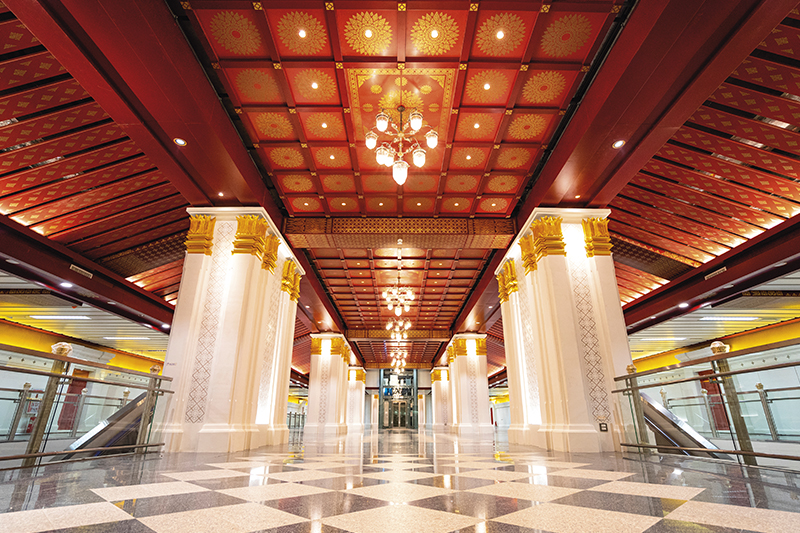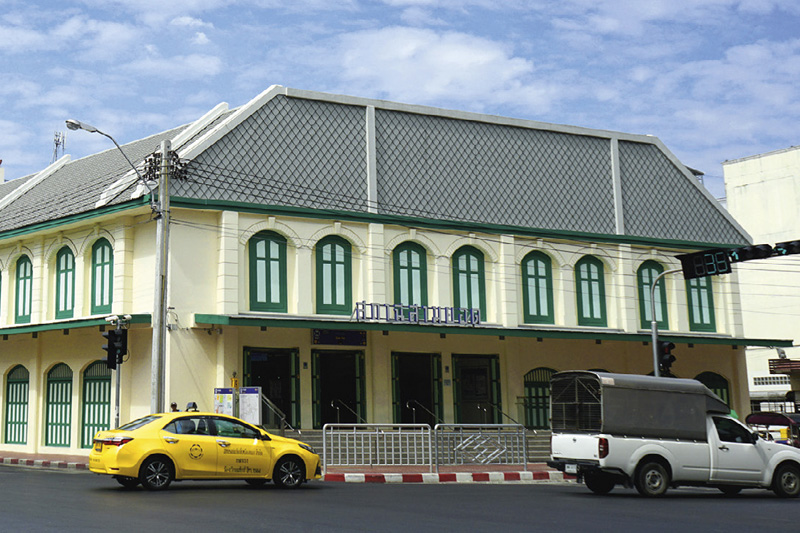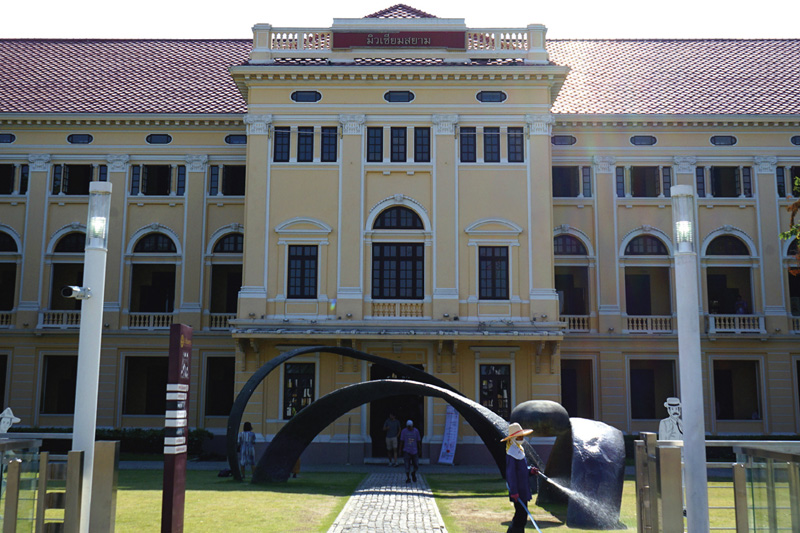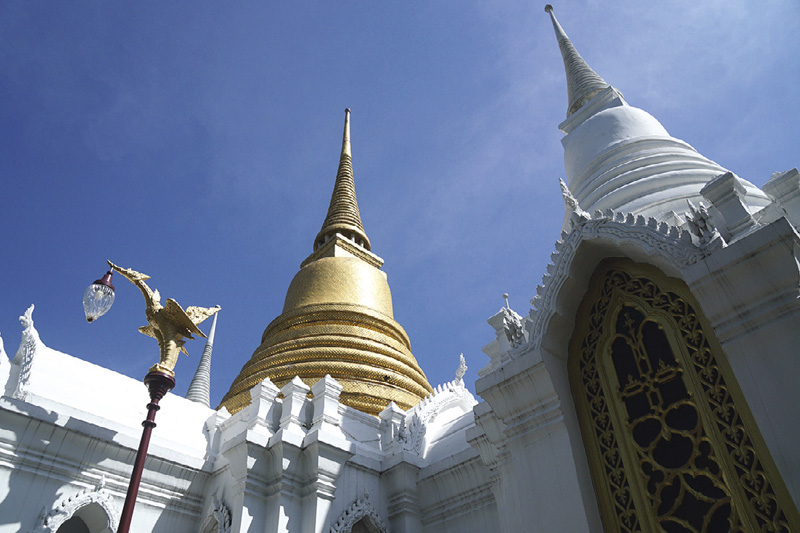
New Passage to the Past
The hidden treasures and transformations of Bangkok’s Chinatown
Words: Phoowadon Duangmee
Photos: Phoowadon Duangmee & @borntotravelbkk
Trains are now the quickest and greenest way to get around Bangkok. That’s all thanks to the MRT’s Blue Line, which has extended westwards from Hua Lamphong MRT station through historic districts, opening a new gateway to Bangko’s Old Town. Visitors now have three MRT stations to get to fascinating neighbourhoods where tradition jostles with transformation.
Wat Mangkon MRT Station: Lost and Found in Chinatown
Dominated by scarlet walls splashed with dragon and phoenix motifs, Wat Mangkon MRT station is a vivid introduction to Bangkok’s Chinatown. The station is named after Bangkok’s largest Chinese temple, which sits just around the corner.
Wat Mangkon is certainly worth visiting for a quick dose of serenity before you venture forth into the hustle and bustle.
A step away from the station’s Exit 1 is Plaeng Nam – a small alley that links Chinatown’s main arteries of Charoen Krung and Yaowarat. In bygone days, the lane was little more than a dumpsite, earning the name Trok Ma Nao (Rotting Dog Strip) for its pungent stink of carrion. Since then, the alley has undergone several transformations and these days it is the best place to find Chinese musical instruments, lanterns and even interesting places to eat. The changes are part of the gentrification of Plaeng Nam and the rest of Chnatown brought on by the new MRT stations.
From Yaowarat Road, the small alley of Yaowa Phanit takes you to Song Wat – a historic bywawy running alongside the Chao Phraya River.
In its heyday, Song Wat was a “spice road” where pepper, cinnamon and various other herbs and spices were hoisted off boats and piled into warehouses. For reminders of Song Wat’s prosperous years, look out for architectural landmarks like the Peiing Building, a venerable and baroque Chinese school, and the opulence of Seng Huad Building with its elaborate woodcarvings.
But don’t be misled by these grand old relics: Bangkok’s historic quarter is now a hipster haunt, brimming with bars, breweries, cafés and interesting shops. A good example is the F.V Café, which serves cold drinks and juice made from the unusual fruits and herbs that grow in the premises’ cool, artistic interior.
Chinatown is Bangkok’s most hectic neighbourhood. It makes for a perfect urban adventure, where half the fun is getting completely lost and finding yourself right in the middle of a well-kept secret.
Wander into the historic riverside community of Talat Noi, and you will find So Heng Tai Mansion. This centuries-old house was built in traditional Hokkien style using golden teak and traditional Chinese techniques. However, the landlord has turned the courtyard into a scuba-diving pool and will usher you through the doors to enjoy a cool glass of juice and the rich Chinese architecture.
A stone’s throw from So Heng Tai Mansion is Baan Rim Nam – where the owner has transformed a run-down warehouse into a lively bar. With its cool river breeze and view of the Chao Phraya, this place is a hidden treasure. Starting out over the water with the city’s roar just a distant murmur behind you, this is a wonderful place to gossip while you enjoy a beer.
Also, good food is never far away in Chinatown.
El Chiringuito, an atmospheric Spanish bar, brings a slice of Madrid with piles of tapas, chorizo pizza, croquettes and homemade sangria. Drooling over Spanish snacks might seem out of the place, as others are slurping wonton soup and egg noodles, but you’re in Chinatown, where nothing is impossible.

Sam Yot MRT Station: Colonial Architecture Hinterland
Unlike its fellow Chinatown stations, Sam Yot MRT is prettier on the outside than within. Located to the west, the station sits in one of the city’s oldest districts – and once its liveliest neighbourhood.
With its wall-to-wall Chinese shophouses in European style, Sam Yot neighbourhood looks at first glance like a hinterland of colonial architecture, even though western powers never managed to gain a foothold in Siam.
Opposite Sam Yot Station is the grand Cacha Bed Heritage Hotel. This architecture treasure was established around 1900 in Victorian style for members of the Thai royal family. For a taste of Bangkok’s days gone by, you could bed down here in the 21st century and wake up in one of their guestrooms circa 1922. The hotel also hosts an art exhibition – where local and international artists take turns to impress and challenge aficionados.
A short walk away in Suan Rommaninat Park. Once upon a time, it was Khlong Prem Prison, which no one wanted to enter. Now it’s a public park – where you can get in and out for pleasure not punishment.
Sam Yot MRT Station is also the portal to historic Chinatown icons like Wat Suthat, the Giant Swing and the Hindu Temple. And when hunger strikes, it’s also home to a promising food scene.
Not far from the Giant Swing is Baan Kanom Pang Khing Café (the gingerbread house), serving up Thai desserts in an olde-worlde ambience. Take time to ponder the intricate fretwork, pitched roof and overhanging eaves, while beating the heat with Italian soda and coconut ice cream.

Sanam Chai MRT Station: In the Heart of Old Bangkok
Designed by national artist Pinyo Suwankiri, Sanam Chai MRT station is a destination in itself. Stepping above ground, it’s also nice to know you’re not far from the Grand Palace, soaring Buddhist temples and heritage buildings. The platform is inspired by the Palace throne hall and comes adorned with ornate columns and motifs.
Wat Pho and the Reclining Buddha are about five minutes away on foot, while the main entrance to the Grand Palace and Temple of the Emerald Buddha is a 20-minute stroll. If you suspect these attractions will be overcrowded, head out from Exit 2 to the temple of Wat Ratchabophit to bathe in the tranquility.
Inspired by the grand buildings that King Rama V saw on his trip to Europe, the chapel hall of Wat Ratchabophit melds Gothic architecture with the traditional Thai gable.
Sanam Chai MRT station is a precious new gateway to Bangkok’s heritage and cultural landmarks, which could previously only be reached via unscrupulous tuk tuk and taxi drivers. Now everyone can explore the city’s palaces and temples all day long. To end the day in style, make a beeline for the Eagle Nest Bar, a riverside watering hole on Maha Rat Road. There, watch Bangkok’s tallest pagoda light up in the dark. The Temple of Dawn is, ironically and magically, more beautiful at night.

จะมีการเดินทางไหนที่สะดวกรวดเร็วและดีต่อสิ่งแวดล้อมไปมากกว่ารถไฟ โดยเฉพาะเมื่อมีรถไฟใต้ดิน (MRT) สายสีน้ำเงิน เดินทางจากสถานีหัวลำโพงไปทางทิศตะวันตก ทอดผ่านเมืองเก่าให้เราได้ยลโฉมย่านแห่งประวัติศาสตร์ใจกลางกรุงเทพฯ ได้ง่ายและไม่ต้องฝ่ารถติด
สถานีวัดมังกร
“สูญหายและได้เจอ ณ เยาวราช”
มองไปทางไหนก็ต้องเห็นกำแพงสีแดงตกแต่งด้วยลวดลายหงส์และมังกรเป็นสัญลักษณ์ของเยาวราชที่แท้จริง ชื่อของสถานีนี้เรียกตามวัดมังกรกมลาวาส เป็นความสุขสงบท่ามกลางย่านแห่งความวุ่นวาย ประปรายด้วยศิลปะแบบจีน
เพียงก้าวออกมาจากทางออก 1 คุณก็จะอยู่บนซอยแปลงนามที่เชื่อมระหว่างถนนเจริญกรุงและถนนเยาวราช สมัยก่อนทุกคนรู้จักกันในชื่อ “ตรอกป่าช้าหมาเน่า” แหล่งทิ้งขยะที่ส่งกลิ่นเหม็นคละคลุ้ง แต่ปัจจุบันได้รับการบูรณะจนเป็นย่านการค้าและเต็มไปด้วยร้านอาหารเลื่องชื่อ
เดินเตร็ดเตร่บนถนนเยาวราชมายังถนนเยาวพานิช แล้วมุ่งสู่ถนนทรงวาดเลียบแม่น้ำเจ้าพระยาอันเป็นถนนแห่งเครื่องเทศที่ส่งตรงมาจากแหล่งเพาะปลูก คุณจะได้เห็นโรงเรียนสอนภาษาจีนเผยอิงซึ่งเป็นอาคารสไตล์จีนบาโร้คและนีโอคลาสสิก หรือจะเป็นตึกเซ่งฮวดที่ประดับด้วยไม้แกะสลักวิจิตรงดงาม รายล้อมไปด้วยบาร์ โรงเบียร์ คาเฟ่ และร้านขายของมากมาย ห้ามพลาดเครื่องดื่มและน้ำผลไม้เย็นชื่นใจที่ทำจากวัชพืชของร้าน F.V Café เด็ดขาด
เดินเลียบแม่น้ำมาไม่นานก็จะเข้าสู่ย่านตลาดน้อย ตื่นตากับบ้านโซวเฮงไถ่ อาคารอายุหลายศตวรรษสไตล์ฮกเกี้ยนสร้างจากไม้สักทองที่ปัจจุบันเปลี่ยนเป็นสระสอนดำน้ำสกูบา เดินลึกเข้าไปอีกจะเจอร้านบ้านริมน้ำซึ่งเปลี่ยนจากโกดังเก่าเป็นบาร์ริมเจ้าพระยาเปี่ยมชีวิตชีวา
และแน่นอนว่าเราต้องไม่พลาดอาหารเลิศรสที่ El Chiringuito สแปนิชบาร์ สถานที่ที่คุณจะได้ลิ้มลองอาหารสเปนรสชาติต้นตำรับ ในขณะที่คนอื่นซดน้ำบะหมี่อยู่อีกร้านไม่ไกลกันนัก
เพราะที่เยาวราช ไม่มีคำว่าเป็นไปไม่ได้
สถานีสามยอด
“อาณาจักรสถาปัตยกรรมอาณานิคม”
ตรงข้ามกับเยาวราชที่มีความงามซ่อนอยู่ภายใน ย่านสามยอดงดงามตั้งแต่ภายนอกด้วยร้านค้าเรียงรายติดกันในอาคารสไตล์อาณานิคม ผสมผสานศิลปะจีนเข้ากับศิลปะยุโรป
มองไปฝั่งตรงข้ามสถานีสามยอด จะเห็นคชาเบดเฮอริเทจโฮเทล สร้างช่วง พ.ศ. 2540 ด้วยสถาปัตยกรรมวิคตอเรียน นอกจากที่พักแห่งนี้จะทำให้เราได้รำลึกถึงอดีตแล้ว ยังเป็นที่ตั้งนิทรรศการศิลปะจากศิลปินทั้งไทยและเทศให้ได้ตื่นตาอีกด้วย
เดินไม่ไกลนัก คุณจะได้สูดกลิ่นอายแห่งร่มไม้ที่สวนรมณีนาถ ซึ่งครั้งหนึ่งเคยเป็นคุกคลองเปรมที่ไม่มีใครอยากย่างกรายเข้ามา หรือจะเดินต่อไปยังวัดสุทัศน์ เสาชิงช้า โบสถ์พราหมณ์ แล้วแวะชิมอาหารเลื่องชื่อให้พุงกาง
อย่าลืมแวะไปบ้านขนมปังขิง ลิ้มรสขนมหวานไทย ชมความงามของงานฉลุ หลังคาลาด และชายคาสุดประณีตระหว่างที่จิบอิตาเลียนโซดาและไอศกรีมกะทิดับร้อน
สถานีสนามไชย
“ใจกลางกรุงเก่า”
สถานีสนามไชยได้รับการออกแบบโดยภิญโญ สุวรรณคีรี ศิลปินแห่งชาติสาขาทัศนศิลป์ ทำให้สถานีนี้เป็นจุดที่ทุกคนต้องมาเชยชม เพียงได้เห็นก็จะรู้ได้ว่าคุณอยู่ไม่ห่างจากพระบรมมหาราชวัง พระอารามหลวง และอาคารมรดกวัฒนธรรมของไทย เพราะประดับตกแต่งด้วยศิลปะจากภายในท้องพระโรง
เดินออกไปเพียงห้านาทีก็จะได้พบกับวัดโพธิ์และพระนอน และเดินเพียง 20 นาที ก็จะถึงพระบรมมหาราชวังและวัดพระแก้ว หากต้องการความสงบเงียบสักหน่อย สามารถเดินออกจากทางออก 2 มุ่งหน้ามายังวัดราชบพิตรได้เลย
คุณจะได้ยลโฉมโบสถ์พุทธที่ตกแต่งภายในเยี่ยงโบสถ์ยุโรปศิลปะโกธิกผสมกลมกลืนกับหน้าจั่วแบบไทย สร้างจากแรงบันดาลใจในรัชกาลที่ 5 ระหว่างเสด็จประพาสยุโรป
แน่นอนว่าการเดินทางเยี่ยมชมสถานที่มรดกวัฒนธรรมไทยใกล้สถานีสนามไชยต้องอาศัยรถตุ๊กตุ๊กและแท็กซี่บ้าง และคงไม่มีใครเดินเที่ยวทั้งวันไหว ก่อนอำลาวันอันแสนเหน็ดเหนื่อย ลองแวะมาที่ Eagle Nest Bar บนถนนมหาราช ชมความงามวัดแปลว่า ยามเช้า แต่ความงามกลับเปล่งประกายในยามค่ำคืน จนคุณไม่มีทางลืมลง
